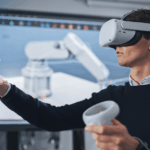Introduction
As companies grow, training requests start flying in from every direction. Sales wants pitch practice. Product needs feature updates. Ops asks for compliance refreshers. It’s tempting to respond with speed: spin up a quick session here, a slide deck there. Fast, flexible, and responsive… until it isn’t.
These one-off, siloed learning solutions occur often across growing organizations. They live in someone’s drive, don’t scale, and inevitably get duplicated the next time another team asks for the same quick fix.
The Hidden Business Risk of One-Off Trainings
One-off trainings don’t just waste time. They waste budget and dilute impact:
- Inconsistent onboarding slows down new hires.
- Duplicate content eats up learning and development bandwidth.
- Outdated materials weaken compliance and credibility.
- Lack of visibility makes it hard for leaders to connect training to business goals.
When leaders ask, “Where do I find training on X?” the answer is often unclear, or worse, “It depends on which team built it.”
That’s why scalable solutions, designed by Instructional Design Consultants, aren’t just an L&D preference. They’re a business strategy.
5 Steps L&D Consultants Use to Transform Ad-Hoc Trainings into a Scalable Learning Ecosystem
Here’s how consultants can replace reactive, ad-hoc trainings with scalable learning ecosystems that support growth:
1. Start with a shared foundation.
Instructional Design Consultants help organizations define a universal “core curriculum” every employee needs. This usually includes:
- Onboarding basics (systems, processes, values)
- Compliance requirements
- Foundational skills (communication, teamwork, customer service)
Once the foundation is set, you can add layers for specific functions or leadership levels. This approach creates consistency and reduces confusion when employees move between teams or departments.
Action tip: Partner with HR and compliance leaders to audit existing onboarding content. What’s consistent? What’s fragmented? Use that audit to decide what belongs in the universal foundation.
2. Use modular learning design.
Instead of building from scratch every time, consultants design reusable building blocks (short video demos, microlearning modules, case studies, and job aids) that eLearning Developers and LMS Administrators can easily repurpose. But here’s the key: modular design only works if your systems support scalability.
Too often, videos or assets get downloaded from a shared drive and re-uploaded into multiple courses. The problem? If that video needs an update, you now have to hunt down every place it was uploaded and manually replace it. That can take hours, or even days.
A better approach is to use embed links or shared repositories that connect back to a single source of truth. For example:
- Host videos in a central platform and embed them into training modules, so updating once updates everywhere.
- Keep job aids in a knowledge base and link them directly, rather than duplicating files across multiple programs.
- Publish microlearning modules in your LMS or LXP with tags, making them searchable and reusable across courses.
When the building blocks are truly modular, one update automatically flows through the ecosystem. This reduces rework, maintains consistency, and ensures learners always see the most accurate version.
Case Study: Designing a Scalable Compliance Program for a Global Media Company
Action tip: Audit how your team currently manages content. Are assets being embedded or duplicated? Start with one high-use item (like a compliance video or sales demo) and move it into a system that supports true modularity. Instructional Design Consultants ensure you move toward one source of truth.
3. Map your learning ecosystem.
Training can’t live in silos. A Learning Experience Designer or Instructional Design Consultant maps the training landscape; what exists, where it lives, who owns it, and how it ties to business outcomes. This reveals duplication, gaps, and opportunities for alignment.
Action tip: If you don’t have a system that supports automated mapping, start with a focused pilot. Pick one department (like Sales Enablement) and manually map their resources. Then, use that example to build the case for investing in a platform or tagging strategy that scales across the business.
4. Put governance in place.
Governance may not sound exciting, but it’s what keeps your programs trustworthy and sustainable. Without it, content gets outdated, duplicated, or ignored. Instructional Design Consultants establish ownership, version control, and review cycles so employees know which content is current. This relieves LMS Administrators and keeps programs sustainable.
Assign ownership for:
- Updating content
- Tracking version control
- Managing access and permissions
Action tip: Establish a quarterly review cycle for high-visibility programs (like compliance or onboarding). Small, scheduled updates prevent massive overhauls later.
5. Collaborate with your stakeholders.
From an L&D perspective, scalable processes make it possible to focus on continuous improvement and upskilling. But stakeholders don’t want to hear about systems and workflows. They want to see business impact. That’s why the real value lies in listening first.
As L&D professionals, every stakeholder conversation is also an “audit”:
- What are the universal learning needs that should feed into foundational programs?
- What challenges are unique to a smaller group?
With the right systems in place, foundational content can expand seamlessly, keeping training both scalable and directly tied to the outcomes leaders care about most.
Ask questions like:
- What business outcome are you trying to drive?
- What’s working with your team’s current training experience?
- What’s missing or unclear for new hires?
- What do experienced employees struggle with most?
From there, you can evaluate whether the need is already addressed in foundational programs (like onboarding, values, or compliance). If it is, the answer can’t simply be: “That’s already covered in onboarding.” Instead, dig deeper:
- What are learners actually taking away from onboarding?
- Are they applying it on the job?
- What gaps remain that might require reinforcement or a leveled-up program?
Download Your Copy of The Essential Guide to Designing a High-Impact Onboarding Program
This collaborative approach allows Instructional Design Consultants to:
- Identify which foundational courses need updates
- Spot opportunities to build add-ons or advanced modules
- Keep leaders engaged as co-owners of the learning strategy
Action tip: In stakeholder meetings, bring sample ecosystem maps or content inventories. Show them where their request fits (or overlaps) in the current landscape, then co-create a plan for either enhancing existing training or building a targeted add-on.
The Training Bottleneck Is Growing: Here’s How to Get Ahead of It
With AI, hybrid work, and constant product updates reshaping how teams operate, the volume of training requests isn’t slowing down. Without a scalable system, L&D teams burn out trying to keep up. With the right structure, every new request becomes an opportunity to strengthen (not splinter) your learning ecosystem.
Scalable training isn’t about saying “no” to requests. It’s about saying “yes, and let’s build it in a way that lasts.”
Partnering With TrainingPros: From Quick Fixes to Scalable Training Success
At TrainingPros, we match organizations with experienced instructional design consultants, eLearning developers, and corporate training experts who know how to design learning ecosystems that scale.
Our consultants don’t just build courses; they help you:
- Reduce duplication across teams
- Improve onboarding consistency
- Align learning solutions with business strategy
- Put governance in place so programs stay relevant and credible
AI is changing the way learning gets designed and delivered, but the real impact doesn’t come from automation alone. It comes from thoughtful design, clear oversight, and leaders who know how to use insights to build trust and growth.
If your team is ready to move beyond one-off trainings and start building scalable learning solutions, TrainingPros can help you connect with the right consultant. We’ve been named a Top 20 Staffing Company by Training Industry, a Smartchoice® Preferred Provider by Brandon Hall Group, and a Champion of Learning by ATD–honors that reflect our commitment to providing top-tier, problem-solving talent.
When you have more projects than people™, let TrainingPros connect you with the right consultant to help you cut through the noise and focus on what matters most.
- 1share
- LinkedIn0
- Twitter0
- Facebook0
- Love This1











